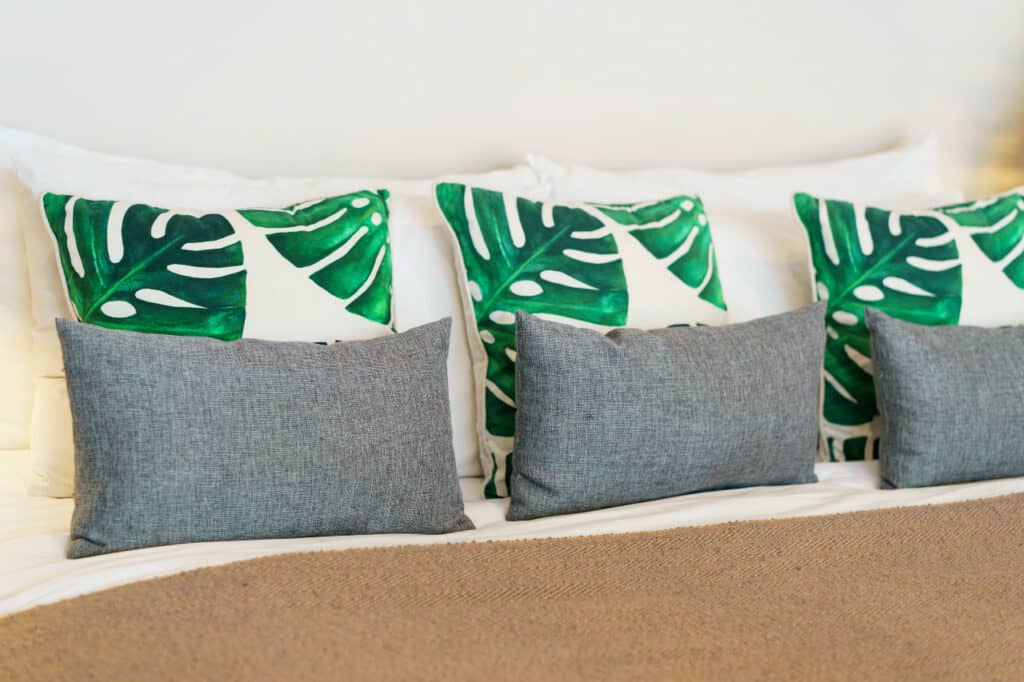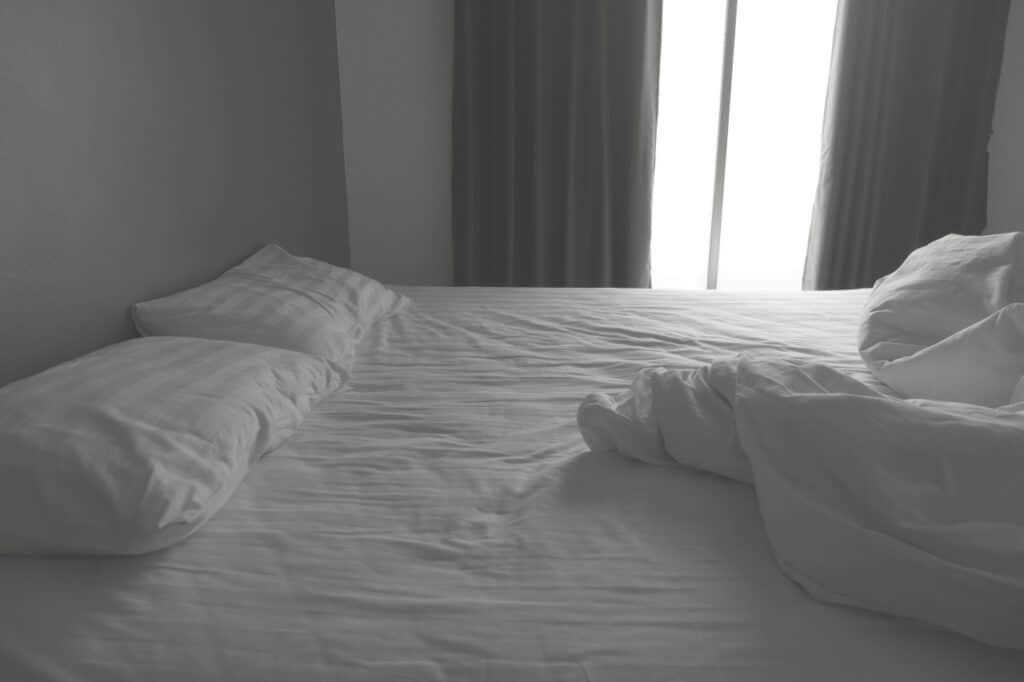What is the Best Quality Bedding?

Bedding is a surprisingly large industry. What it’s made of, how it’s made, and the layers you incorporate into your bed design can vary wildly. Perhaps you make beds with a simple fitted sheet and covered duvet, or you enjoy making a ten-layer hotel bed. Whether you’re making beds for yourself, for guests, or even a hospitality business, quality is king.
The quality of your bedding determines how comfortable it is, how luxurious the bed feels to lay in, and the quality of sleep delivered throughout the night. You need flat sheets or luxury sheets that are breathable in warm weather, warm in cool weather, while also being exquisitely soft and smooth to the touch. However, shopping for bedding can be a whirlwind of material, synthetic fibers, weave, thread count, and even the origin of the plant fibers. Which is the best? How do you find the best quality bedding for your somnolent arrangement?
As bed experts, No Bull Mattress & More is here to give you the straight facts about finding the best quality bedding.
Cheapest to Best Sheets
- Low-thread-count cotton and poly-blend sheets
- Microfiber sheets
- Mid-thread-count cotton and average cotton-alternative sheets
- Long-Staple Cotton and Linen Sheets
- Luxury cotton-alternative sheets
- Luxury cotton, linen, and silk sheets
First, let’s talk about the range of sheet quality. No doubt, you’ve heard people gush about Egyptian Cotton and high-thread-count sheets. These things matter, they really do. But Egypt and thread count also aren’t the end-all, be-all of high-quality bedding. In fact, as the industry moves to materials beyond just cotton, linen, and silk, we also see new ways to measure bedding quality, like percale sheets.
The range begins at scratchy, low-thread-count cotton and poly-blend sheets, through cotton and cotton-alternative sheets of average thread count and quality, then striates at high-quality sheets into selective materials and qualities you may be shopping for. This includes weave, breathability, moisture-wicking, and ultimate softenss.
Microfiber: Cheap Sheets are Pretty Soft These Days
Microfiber has saved most people from sleeping on the worst quality sheets because it offers fairly soft and reasonably breathable sheets for affordable prices – a huge improvement over low-thread-count scratchy cotton sheets. As one of the miracles of the plastic industry, microfiber is officially woven plastic – polyester and nylon – but you wouldn’t believe it to touch these sheets.
Microfiber sheets feel like jersey sheets – a soft, stretchy t-shirt-like material that fits snugly yet easily over your mattress. If you need to cover a lot of beds fast, or stock a bedroom on a serious budget, microfiber is now the practical baseline. Wrinkle-resistant, color locked, and unlikely to pill, microfiber is an economic and reasonably comfortable low to mid-range bedding option with design and solid colors.

Cotton Sheets: Thread Count, Staple, and Weave
Cotton sheets have long been the foundation of bedding quality. Where the cotton comes from, how many threads, how the threads are woven, and even the length of the cotton fiber all play an important role in bedding quality.
The best cotton bedding has:
- Moderate to high thread count
- 500-1000
- Long-staple cotton fibers
- The right weave for the season
- Percale, satin, or flannel weave
How Thread Count Determines Bedding Quality
- < 300 Low Thread Count
- 300 – 800 Mid Thread Count
- 500 – 1000 High Thread Count
- 1500 + Dense Thread Count
When most people talk about bedding quality, they talk about thread count. High thread count is considered to be smooth and luxurious (like egyptian cotton) while low thread count is considered to be rough and low-quality. While the trend is correct, the numbers are not a perfect scale. The comfortable range of thread count is 300 to 1000, which includes most modern sheets and duvet covers. Below 300 and you can feel the separate fibers, while above 1000, the thread count can become so dense that the sheets lose breathability in favor of smoothness.
In addition, it’s important to remember that a two-ply yarn can double the thread count with the same density of weave. This is why thread count range overlaps between mid-range and high-range thread counts.
The best quality cotton flat sheet typically have a thread count between 500 and 1000, balancing the smoothness of dense quality threads and the breathability of a looser weave.
Long-Fiber Cotton Sheets are the Softest
The other factor in cotton bedding quality is the staple, or the length of the cotton fiber. Long-staple cotton is softer than shorter staple cotton, which means that no matter what the thread count, long-staple cotton bedding will be of a higher quality compared to other sheets of the same count.
The Right Weave for the Season
Finally, there’s the weave of your cotton flat sheet. Percale flat sheet is a tight, smooth yet breathable weave that is the most crisp and cooling. Hotels tend to prefer percale flat sheet weave and it’s recommended for high-quality summer bedding. Flannel is a soft, fuzzy weave that is heavy yet breathable and is best in the winter.
Satin, contrary to popular belief, is a type of weave that is very smooth and silky, but not as breathable.

Luxurious Alternatives to Cotton Bedding
- Linen Sheets
- Silk Sheets
- Bamboo Sheets
- Wool Sheets
- Tencel (Eucalyptus) Sheets
- Synthetic Moisture-Wicking Sheets
What about high-quality bedding that is not cotton? You can find luxurious bedding in other fabric types. Linen has long been considered highly luxurious when finely woven. It is heat-wicking, light, and very soft, but also highly wrinkleable. Silk sheets are the definition of luxury, but even silk can be rough if you don’t find silk bed sheets of good quality since there is such a wide range .
Bamboo and Tencel sheets are popular sustainable alternatives and can be both breathable and moisture-wicking in soft bedding. However, there is less of an established system for determining quality bedding in these fabric alternatives. You will need to trust your brands, manufacturers, and reviews.
What is the Best Quality of Bedding?
Finding the best quality bedding depends on your plans, decor, and the sleeping environment. For cotton sheets, the answer is definitely about long staples and mid-to-high thread counts, even when it comes to organic cotton, and linen is often measured with similar means. In warm environments, the best quality bedding is breathable, yet weighty enough to help one sleep. Cool percale woven sheets and light duvets or quilts are the popular and elegant choices, while winter bedding luxuriates in layers of different fabrics and densities.To find the best quality bed and bedding for your residence or hospitality intentions, or to learn more about the history of bedding, contact us today or explore the No Bull Mattress & More online store for yourself.
SOURCES:
https://www.bobvila.com/articles/what-is-microfiber/
https://naplab.com/guides/what-does-thread-count-mean/
FAQs
The best material for bedding is subjective and depends on personal preference. However, high-quality cotton, linen, and silk are popular choices.
Thread count refers to the number of threads woven into one square inch of fabric. While a higher thread count can indicate better quality, it is not the only factor to consider.
Sateen bedding has a silky, smooth finish and is made with a satin weave. Percale bedding has a crisp, cool feel and is made with a plain weave.
Dreaming about Getting Better Sleep?
we've got a friendly, knowledgable, passionate-about-sleep, straight-shooting, no bull sleep expert near you.


